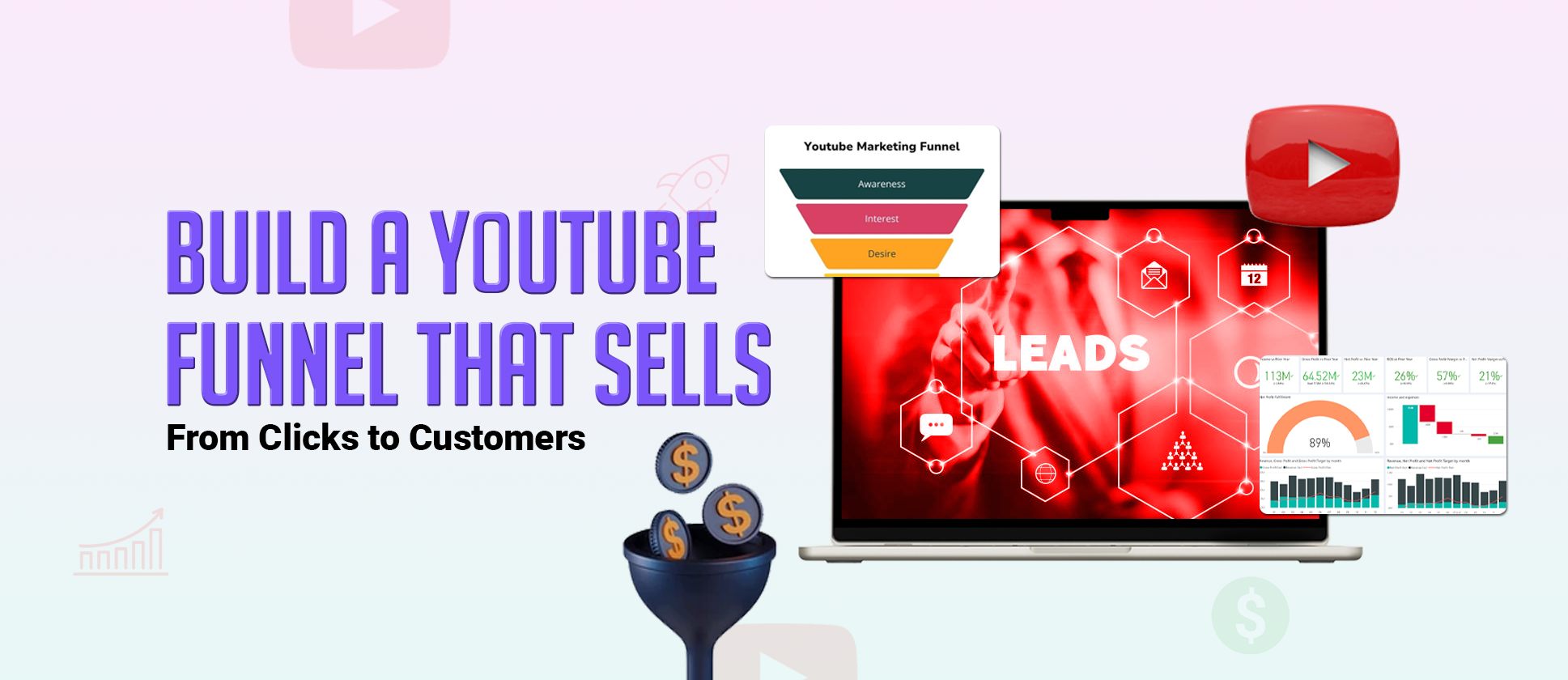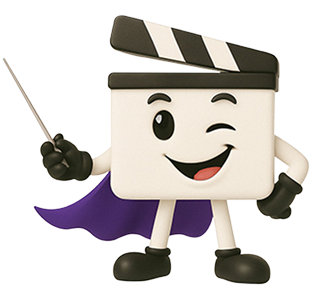Quick Summary
TL;DR: A high-converting YouTube Sales Funnel guides viewers from discovery to purchase with the right mix of educational videos, trust-building content, and persuasive offers. This guide will help you build a high-converting sales funnel with key stages and strategies. #tldr
- Core Idea:
A YouTube Sales Funnel isn’t one video. It is a path that moves viewers from awareness to consideration and finally to action through consistent, helpful content.
- Key Stages:
Awareness → Tutorials & Reviews → Demos & Offers
- Top Insights:
How to plan your funnel in 7 simple steps → How to structure your channel and playlists for conversions → How to use Shorts, SEO, and paid ads to drive traffic → How to build stronger CTAs and lead magnets
- Main Takeaway:
If you want results in 2026, treat YouTube like a full customer journey. Build trust with useful content, guide viewers with clear next steps, and rely on data to refine your funnel until it consistently converts.
Video content is now the main focus of the internet, and a good YouTube sales funnel is becoming one of the best strategies for 2026. Brands are moving away from general content to focus on getting results. YouTube effectively captures attention and helps turn viewers into customers. According to Limelight Digital, with over 2.7 billion active users globally, YouTube ranks among the most influential platforms for marketers seeking real impact.
In this guide, you’ll discover everything you need to build a high-converting YouTube sales funnel – from each funnel stage and the right video types, to traffic generation, lead capture, and tracking your results. And if you’re curious about visual storytelling in video, you may find our post on What is Video Storytelling useful for linking the content flow.
What Is a YouTube Sales Funnel and Why It Matters in 2026
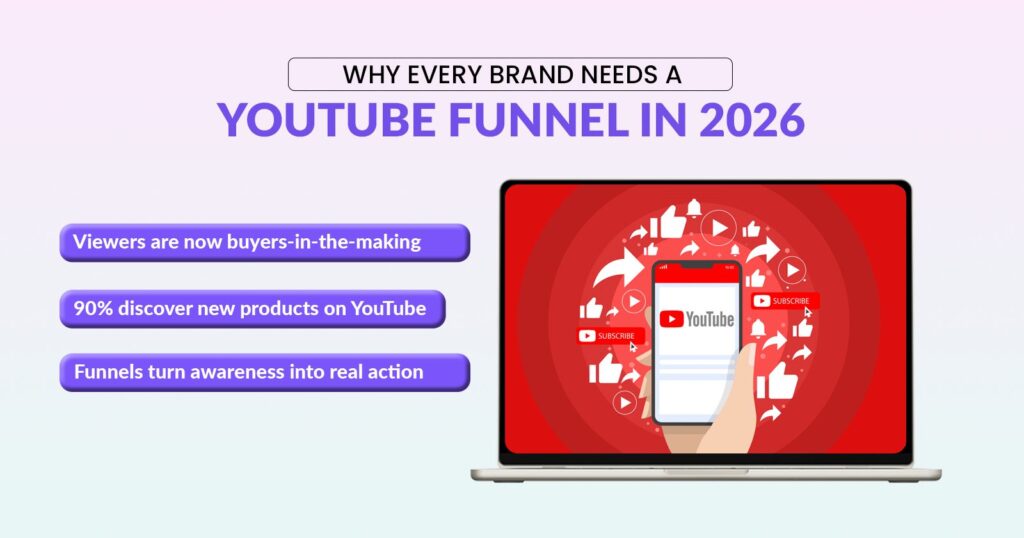
A YouTube sales funnel is a path that takes viewers from finding your videos to becoming loyal customers. A YouTube funnel relies on engaging content to build trust over time. Each video plays a specific role from awareness and interest to conversion and retention, making it one of the most effective tools for today’s video-first world.
What makes YouTube unique is how naturally it fits into the customer’s decision-making process. People come to YouTube to learn, compare, and evaluate before they buy, which gives brands a chance to educate and connect before pitching. As viewing habits evolve, this video-centric approach has become even more powerful. According to recent data, over 90% of users say they discover new products or brands on YouTube before making a purchase decision.
This evolving landscape has also brought new challenges, such as maintaining compliance and avoiding YouTube demonetization. Knowing these rules early helps creators build sustainable funnels without disruptions.
| Funnel Type | Platform Example | Goal | Viewer Action |
|---|---|---|---|
| Traditional Sales Funnel | Website | Convert through form fill | Click or buy |
| YouTube Sales Funnel | Video Content | Convert through engagement | Watch, click, subscribe |
The 3 Key Stages of a YouTube Sales Funnel
A YouTube Sales Funnel works best when you treat it as a journey rather than a single video strategy. Each stage serves a different purpose, bringing new viewers in, building trust, and finally turning that trust into action. Knowing how to handle each phase helps you create content that connects smoothly from one stage to the next. This keeps your audience interested and wanting to know more.
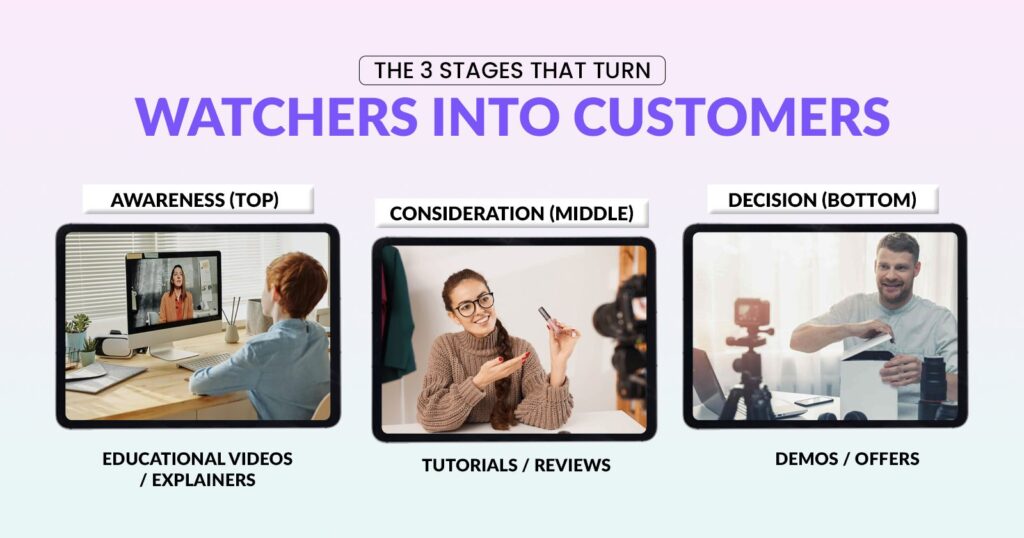
Top of the Funnel (Awareness Stage)
In the awareness stage, your main goal is to grab attention and educate your audience. Most viewers do not know you yet, so focus on providing value instead of trying to sell something. Use videos like explainers, educational content, or simple storytelling clips. These formats spark curiosity without overwhelming your audience.
For visibility, optimize your SEO by using relevant keywords in your title, description, and tags. A strong thumbnail and clear headline also go a long way in helping your video stand out in search results and recommendations.
CTA Focus: Encourage viewers to subscribe or learn more about the topic in your next video.
Mistakes to Avoid
- Using clickbait titles that don’t match your content
- Starting with long intros that delay the main message
- Ignoring viewer retention metrics in early videos
Middle of the Funnel (Consideration Stage)
Once viewers start engaging with your content, it’s time to build trust and show credibility. In this stage, focus on tutorials, webinars, behind-the-scenes content, or expert interviews. These video types give viewers a reason to believe in your brand while showing the real value you offer.
To increase engagement, add polls, Q&A prompts, or pinned comments. These small touches invite interaction and help YouTube’s algorithm recognize your videos as relevant and engaging.
CTA Focus: Encourage viewers to join your newsletter, explore your playlist, or watch a related video.
If you want to monetize effectively at this stage, read our YouTube Monetization Guide, which explains how to place videos strategically and align your funnels to increase revenue and build trust.
Bottom of the Funnel (Decision Stage)
This is where interest leads to action. The goal now is to turn viewers into customers. Use product demos, testimonials, case studies, and special offers. These show real results and clear benefits.
Your script should be short and persuasive. Start by restating the viewer’s problem. Then, introduce your solution and end with a strong call to action. For example, “Still unsure if this fits your needs? Try it free for seven days and see the results for yourself.”
CTA Examples
- Book a demo
- Claim your free trial
- Buy now
Here’s a simple structure for a decision-stage video
- 1. Recap the problem briefly
- 2. Introduce your product or service
- 3. Show quick results or testimonials
- 4. Close with a limited-time offer
| Funnel Stage | Video Type | CTA | KPI to Track |
|---|---|---|---|
| Awareness | Explainer / Educational | Subscribe | Views & Watch Time |
| Consideration | Tutorial / Review | Visit Website | CTR & Comments |
| Decision | Demo / Offer Video | Purchase / Sign-Up | Conversion Rate |
How to Build a High-Converting YouTube Sales Funnel Step-by-Step
To create a successful YouTube sales funnel, start with a clear plan. Instead of just uploading videos and waiting for results, guide your viewers on a path. Help them become aware of your content, build trust, and encourage them to take action. Understand your audience, set up a channel that clearly reflects your brand, and organize content for each stage of the funnel. This approach will attract the right viewers and encourage them to move closer to making a purchase.
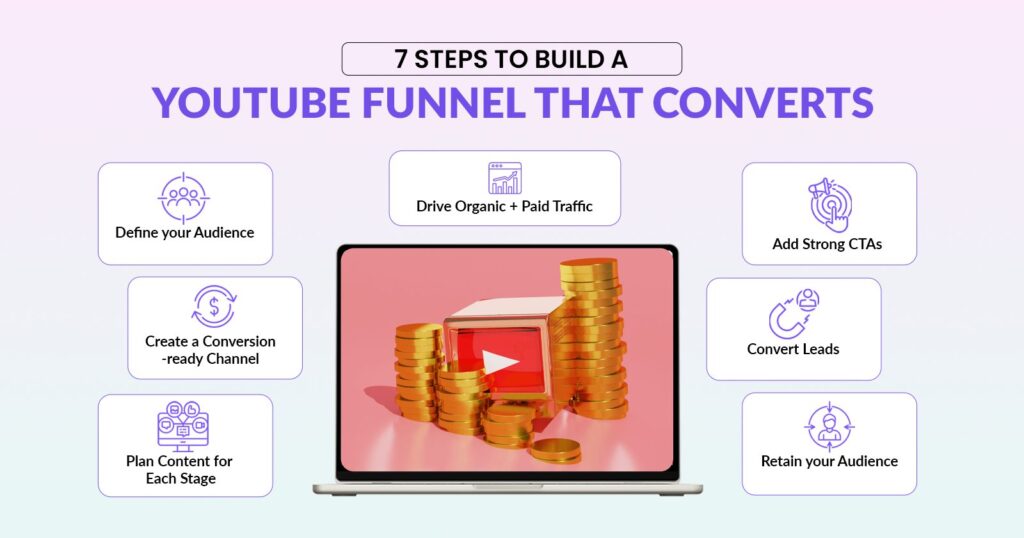
Step 1 – Define Your Audience
To create a successful funnel, you need to know your audience well. Start your research by looking at more than just basic demographics. Use YouTube Analytics to learn about your viewers’ age, location, and watching habits. You can also check Google Trends and read your comment section to find common questions, content gaps, and what your audience likes.
After collecting this information, create simple viewer profiles. Create profiles of your ideal viewers, focusing on their challenges and what drives them to watch your videos. Make sure your content matches their needs, not just your own interests. This will help your videos appear in relevant searches and keep viewers interested from the start.
If you’re not sure where to begin, look at your YouTube analytics to see which videos keep viewers watching the longest and which topics they find interesting. This will help you refine your strategy effectively.
Step 2 – Create a YouTube Channel That Converts
Think of your channel as your digital storefront. When someone lands there, every element should reinforce who you are and why they should stay. Start with clear branding: your banner, logo, and channel description should communicate what your content offers and who it’s for.
Organize playlists around the stages of your funnel. One playlist can introduce your brand (Awareness), another can share in-depth tutorials or reviews (Consideration), and the last one can highlight product demos or client stories (Decision). This setup keeps viewers moving through your funnel without confusion.
Use SEO tags strategically, but don’t overstuff them. Focus on intent-based keywords that your audience actually types into search. Use compelling thumbnails and do consistent posting, and you’ll turn your channel into a conversion-ready hub.
Step 3 – Plan Content for Every Funnel Stage
To have a strong funnel, you need consistency. A simple YouTube content calendar can help you stay organized. It will ensure that each video fits your funnel strategy. A helpful ratio to follow is 40:40:20, where 40% of your videos focus on awareness, 40% on nurturing trust, and 20% on driving conversions.
Each stage should feel connected, not forced. Your awareness videos should naturally lead to consideration content, and from there, your decision-stage videos should make it easy for viewers to take action.
If you’re producing videos that aim to sell or persuade, studying how to write perfect VSL copy can help you structure your scripts with stronger hooks and emotional flow, all key to improving your funnel’s performance.
Step 4 – Drive Organic and Paid Traffic
After you set up your funnel, the next step is to attract viewers. Start with video SEO by creating clear titles that include keywords your audience is searching for. Use eye-catching thumbnails and write descriptions that clearly explain what your video is about for both YouTube and your viewers. Small tweaks like timestamps, captions, and pinned comments can also help boost engagement and watch time.
Don’t limit yourself to one format. Mix in YouTube Shorts for quick attention-grabbing clips, use Community posts to start conversations, and share your videos across platforms like LinkedIn or Instagram to drive fresh traffic.
When you’re ready to scale, experiment with paid options such as TrueView, discovery, or in-stream ads. They’re powerful tools for putting your videos in front of targeted audiences who are already interested in your niche.
Step 5 – Add Strong CTAs and Lead Magnets
A video without a clear next step is a missed opportunity. Your call-to-action (CTA) guides viewers toward taking that next move, whether it’s subscribing, signing up, or making a purchase. Try placing CTAs strategically, inside the video script, in end screens, or in the description box.
You can strengthen your CTAs with lead magnets like free checklists, video guides, or short templates that add real value. For example, a digital marketing channel might offer a free “YouTube Optimization Checklist” in exchange for an email.
Here’s a simple reference for planning your CTAs.
| CTA Type | Placement | Funnel Stage | Example Text |
|---|---|---|---|
| Subscribe | Within video | Awareness | Join our channel for weekly tips. |
| Download | Description | Consideration | Get your free checklist below. |
| Book a Demo | End Screen | Decision | See how it works in 10 minutes. |
Step 6 – Convert Viewers into Leads and Customers
At this stage, your YouTube Sales Funnel starts doing the heavy lifting. You’ve built awareness and trust, and now it’s time to convert interest into action. Offer special deals, free trials, or discounts for a limited time to encourage people to act quickly without feeling pressured.
Use retargeting ads to reach people who watched your videos but did not make a purchase. Tools like Google Tag Manager can help you track viewer behavior. Then, you can show them ads that guide them back to your offer.
Step 7 – Nurture and Retain Your Audience
Keeping your customers engaged for longer terms is key to real growth. Create onboarding videos to help new clients use your product or service. Send short, helpful emails to stay in touch.
Run retargeting campaigns to reconnect with past visitors and encourage them to explore advanced products or new features. Ask for reviews, share customer success stories, and invite your community to give feedback or share ideas.
Tools & Analytics to Optimize Your YouTube Sales Funnel
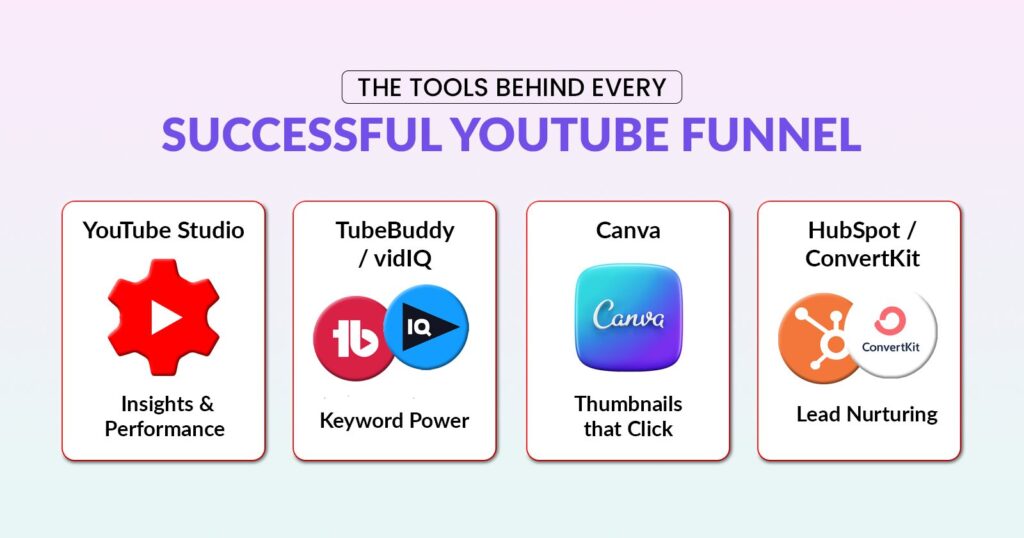
To get the most from your YouTube Sales Funnel, you need the right tools and data to guide your next steps. Great funnels are built on insight, not guesswork. The right mix of creative and analytical tools helps you understand what’s working, what’s not, and where your viewers drop off. These tools simplify and strengthen every stage of the funnel from managing your videos to tracking engagement and nurturing leads.
Tools to Build and Manage Your Funnel
Start with YouTube Studio. It is your main tool for publishing videos, improving them, and tracking how they perform. YouTube Studio gives you insights into how viewers engage, how long they watch, and who they are. Use TubeBuddy or vidIQ to find effective keywords, test your thumbnail options, and check on your competitors’ strategies.
For creating consistent visuals, use Canva. You can design professional thumbnails and graphics that match your brand. After your sales funnel starts generating leads, use tools like HubSpot or ConvertKit to automate follow-ups, create email sequences, and manage contacts easily.
If you’re already exploring automation for your content creation and management, you can learn more about how AI can save time and boost output through AI automation tools.
Key Metrics to Track Funnel Performance
Your funnel is only as good as the data you track. Monitoring performance metrics helps you see where viewers engage most and where they drop off, so you can fine-tune your approach.
Here are a few key metrics to keep an eye on.
- Watch time and retention rate: Measures how long viewers stay engaged. The longer they watch, the more trust and relevance your content builds.
- Click-through rate (CTR): Tracks how many people click your thumbnails or links. A higher CTR often points to strong visuals and effective titles.
- Conversion and lead generation: Shows how many viewers take the next step, whether it’s signing up, subscribing, or making a purchase.
| Metric | Stage | Tool to Measure | Optimization Tip |
|---|---|---|---|
| Watch Time | Awareness | YouTube Studio | Hook attention in the first 10 seconds |
| CTR | Consideration | TubeBuddy / vidIQ | Test different thumbnails and titles |
| Conversion Rate | Decision | Google Analytics / HubSpot | Simplify CTAs and landing page flow |
The more consistently you track these metrics, the faster you’ll uncover patterns that help refine your content, CTAs, and ad targeting. It will make your YouTube funnel smarter and more profitable over time.
Common Mistakes to Avoid When Building a YouTube Sales Funnel
Even the best strategies can fall flat if you overlook the basics. When creating your YouTube Sales Funnel, small missteps can stop viewers from moving further along the journey from discovery to conversion. The good news is that most of these mistakes are easy to fix once you spot them. Let’s go through the most common ones and how to avoid them.
Mistake 1 – Focusing Only on Views
It can be tempting to focus on getting high view counts, but views don’t always mean success. A video that gets thousands of views but doesn’t lead to sign-ups or sales doesn’t help your sales funnel. Instead of just looking at numbers, pay attention to important metrics like retention rate, comments, and link clicks. These show whether your audience is genuinely engaging with your content and moving closer to your offer.
Mistake 2 – Weak or Missing CTAs
If you don’t tell viewers what to do next, they’ll likely do nothing. Many creators overlook the importance of clear buttons that guide viewers on what to do next. Use direct phrases like “Download our free guide” or “Join our email list for tips.” Include clickable links in the description and ensure the call to action (CTA) stands out in your video design.
Mistake 3 – Not Aligning Content with Funnel Stage
Every video should have a clear purpose in your marketing funnel. At the awareness stage, videos should educate and attract viewers. For the consideration and conversion stages, the focus should be on building trust and encouraging action.
A common mistake is mixing these goals in one video or skipping stages. Make sure to create a balanced mix of videos that guide viewers step by step, from learning about your brand to making a purchase or signing up.
Mistake 4 – Ignoring Analytics and Feedback
Analytics provide insights into what your audience likes, skips, and responds to. Ignoring this data can lead to missed chances to improve. Check your analytics and latest YouTube marketing trends regularly to see how your content performs, who your audience is, and how long they watch. Also, look at the comments; they often provide valuable ideas, feedback, and inspiration for your future content.
Quick Fix List
- Align each video with a specific funnel goal
- Add verbal and visual CTAs in every video
- Review analytics weekly to adjust strategy
- Engage actively with comments and community posts
Future Trends for the YouTube Sales Funnel in 2026
Audiences are changing how they find and engage with content, so your YouTube Sales Funnel should adapt. As we head into 2026, new tools, algorithms, and viewer habits are shaping how creators and brands get attention and turn interest into action. Keep an eye on these ongoing trends to stay ahead.
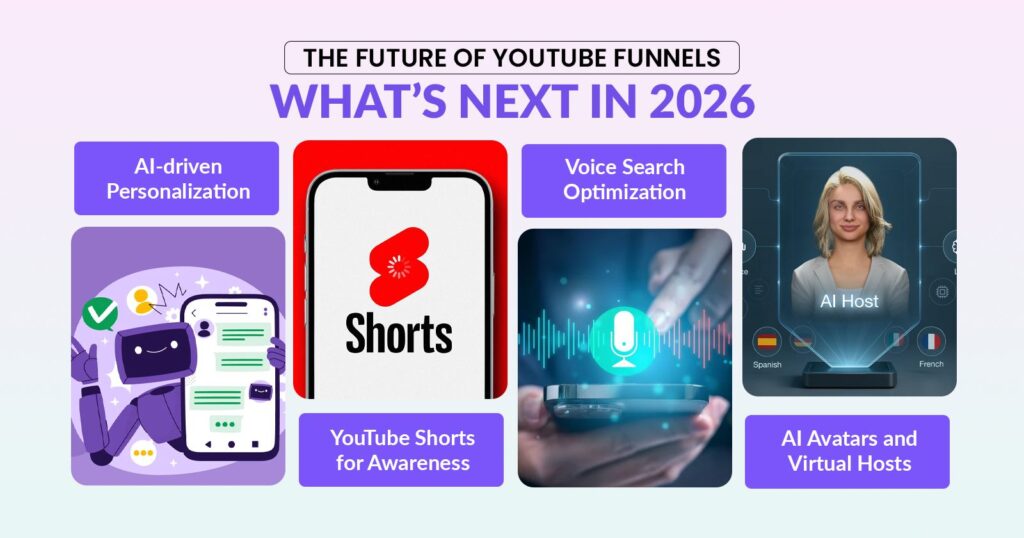
Rise of AI-Driven Recommendations and Personalization
AI is improving at understanding how viewers behave and what they want. YouTube now focuses on creating personalized experiences instead of just measuring watch time. This means your content is more likely to reach the right audience if it is relevant and engaging. We can expect YouTube to provide more tailored video suggestions based on individual interests, rather than just using keywords or categories.
Integrating YouTube Shorts into Funnel Stages
YouTube Shorts have become a powerful tool for top-of-funnel awareness. They’re short, fast, and great for pulling in new audiences who might not yet be familiar with your brand. Successful creators use Shorts to preview longer videos, promote their offers, and drive traffic to landing pages.
Voice Search and Video SEO Evolution
The way people search for videos is changing with AI voice assistants becoming more common. Phrases like “how to start a YouTube funnel” or “best video strategy for business” are being spoken more than typed. Optimizing your titles, descriptions, and scripts for natural language can help capture these queries. Video SEO is no longer about stuffing keywords; it’s about matching real search intent.
Using AI Avatars or Virtual Presenters in Marketing Videos
AI avatars and virtual hosts are starting to appear in more branded videos. They save production time and make localization easier since you can create multiple versions of the same message in different languages or tones. When used thoughtfully, AI presenters can make your funnel scalable while keeping your content consistent and professional.
Final Thoughts
Building a YouTube Sales Funnel is about getting more traffic and building trust. You can guide viewers through every stage and turn that attention into loyal customers. Keep improving your funnel by experimenting with new content types, reviewing performance metrics, and listening to your audience. Small adjustments often make the biggest difference over time.
Ready to create your own sales funnel? Explore how ShortVids can help with professional video editing, smart analytics, and conversion-focused storytelling that drives real results.
FAQs About YouTube Sales Funnel
A YouTube sales funnel is a method that helps viewers go from watching your videos to becoming paying customers. It changes casual viewers into loyal customers by pairing engaging content with clear calls to action.
It usually takes 4 to 8 weeks to create a solid YouTube funnel, depending on your video volume, production workflow, and content strategy. Consistency and testing are key.
Start by defining your audience, planning content for each funnel stage (awareness, consideration, decision), and setting clear CTAs. Use tools like YouTube Studio and analytics to measure what’s working.
Yes, YouTube Shorts are great for the top of the funnel. They help you capture attention quickly and drive viewers to longer, conversion-focused videos.
You can use Google Analytics, YouTube Studio, and CRM tools like HubSpot to track leads, engagement, and conversion rates.
Review your funnel metrics at least once a week to catch early trends and adjust your strategy before issues grow.
It varies by industry, but most businesses start with $500 to $1,500 per month for testing. Once you find what works, you can scale confidently with data-backed results.
Book a Call Today
- Fixed monthly plans starting at $999
- 24-hour turnaround time (or less) on all short-form edits
- 3-layer quality check system on every video
- No more chasing freelancers or managing editors
- Scale up to 50+ videos/month without hiring in-house
- Content team trained on platform trends, scroll-stopping hooks & storytelling
- Fully managed by professionals – you just upload & approve
- Response time: Under 1 hour (US & GCC time zones)
Cut your production costs, not your standards.

